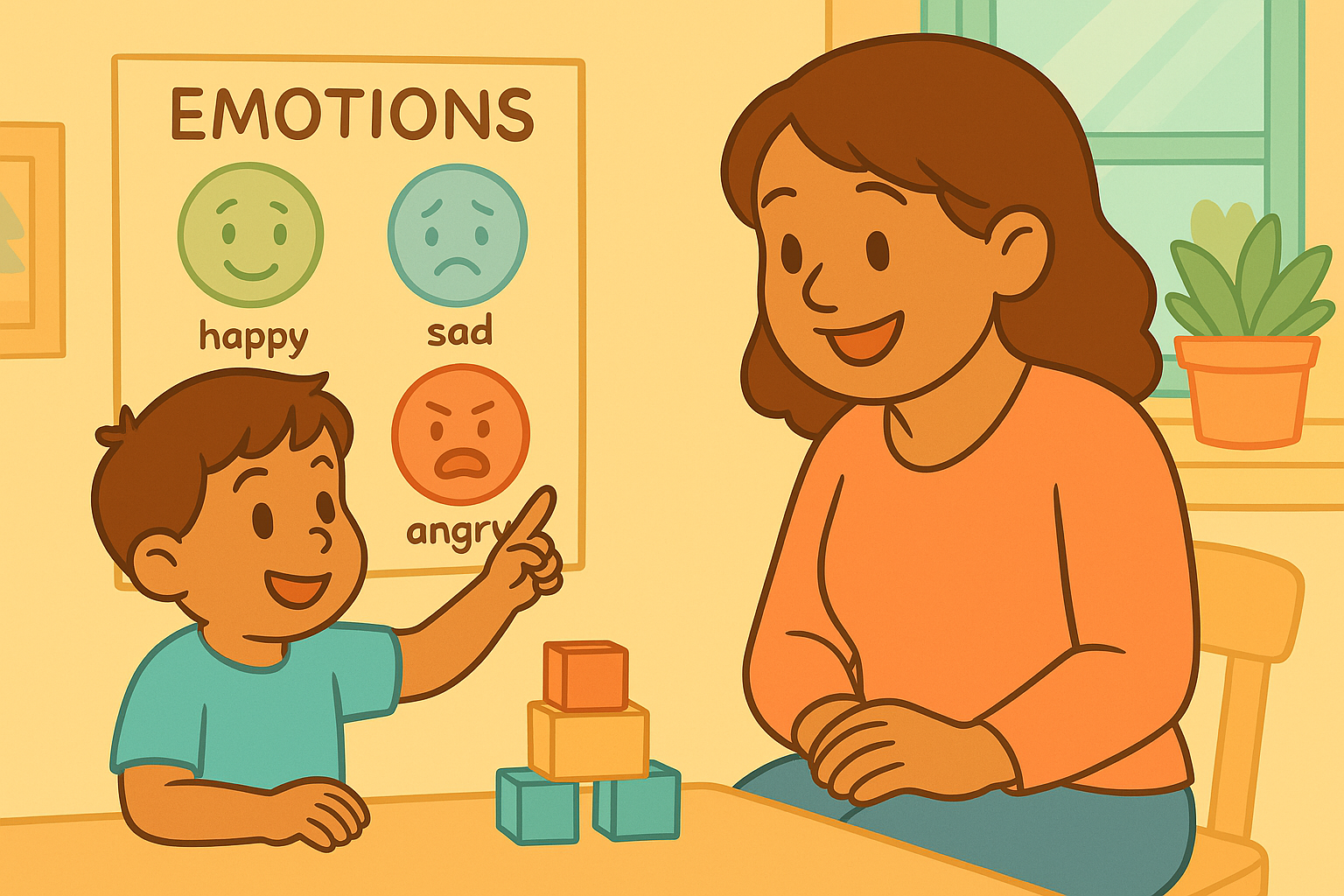The Power of Naming Emotions in Early Learning
The Power of Naming Emotions in Early Learning
Why Naming Emotions Matters
When young children can name their feelings — “sad,” “frustrated,” “excited,” “curious” — something powerful happens inside the brain.
Emotion-labeling:
Reduces stress responses
Strengthens self-regulation
Improves social behavior
Boosts learning readiness
Builds empathy
Children who can name emotions have fewer meltdowns, more successful peer interactions, and greater confidence navigating change.
And it all starts with just one word: “I feel…”
Naming Emotions Is a Thinking Skill
Emotions begin in the body (tight tummy, shaky hands, warm cheeks) — but language helps the brain organize those sensations.
When you say:
“It looks like you’re frustrated,”
Your child’s brain associates:
a feeling,
a body sensation,
and a word.
That creates emotional literacy — the foundation for social-emotional growth.
Step 1: Narrate Feelings in Real Time
Children don’t always know what they feel. You can narrate gently:
“You look disappointed we can’t play outside.”
“You seem proud of your tower!”
“That noise surprised you.”
This validates feelings and expands vocabulary.
(Try this too: The Power of Positive Reinforcement in Early Learning)
Step 2: Use Visual Tools
Emotion charts, puppets, and picture books help children see emotions.
Try:
pointing to a face on a chart,
using magnets to match moods,
or inviting your child to draw how they feel.
When emotions become tangible, they become manageable.
Step 3: Name Emotions for Other Characters
Books and pretend play offer low-pressure practice.
Ask:
“How is the bear feeling right now?”
“Why do you think the puppy looks worried?”
Connecting story emotions to real life builds empathy.
(Related read: Using Puppets to Reenact Books and Stories)
Step 4: Introduce a “Feelings First” Routine
Before solving a problem, name the feeling.
For example:
Name: “You feel frustrated.”
Normalize: “Everyone feels that sometimes.”
Navigate: “Let’s take a breath together.”
This teaches that feelings aren’t dangerous — they’re signals.
Step 5: Provide Feeling Words Beyond “Mad” and “Sad”
Young children often default to basic labels. Offer alternatives:
frustrated
disappointed
confused
nervous
excited
proud
silly
calm
Specific vocabulary = specific coping strategies.
Step 6: Connect Feelings to Body Sensations
Ask:
“Where do you feel that in your body?”
This builds self-awareness.
Example body cues:
Tight hands = frustration
Heavy shoulders = sadness
Fast feet = excitement
Children learn to identify emotions before they explode.
(Also see: Building a Calm-Down Corner That Actually Works)
Step 7: Model Your Own Feelings
Children learn emotionally by watching adults.
You might say:
“I’m feeling excited to bake cookies together!”
“I’m disappointed something didn’t work, so I’m going to take a breath.”
This models transparency, not perfection.
Step 8: Celebrate Emotional Bravery
Emotional honesty is courage.
Praise moments like:
talking instead of pushing,
asking for help,
naming feelings without shame.
Try:
“You worked through frustration — wow.”
“Thanks for telling me how you feel.”
Validation builds resilience.
Step 9: Avoid Minimizing Feelings
Phrases like:
“You’re fine.”
“Don’t cry.”
…teach kids to hide emotions.
Try instead:
“You’re safe. I’m here.”
“Your feelings make sense.”
Connection calm the nervous system.
(Try this too: How to Foster Joy in the Learning Process)
Step 10: Regulate Together (Not Alone)
Co-regulation means sharing calm until they can do it independently.
Try:
shoulder hugs,
breathing together,
counting slowly,
squeezing a pillow.
Over time, children internalize your calm voice as their own.
Emotional Literacy Helps in School, Too
Children who can name emotions:
transition more smoothly,
follow directions better,
form healthy friendships,
recover from mistakes quicker.
Teachers notice — and appreciate — regulation and empathy.
(Related read: Helping Kids Transition to Kindergarten Smoothly)
When Children Struggle to Name Feelings
Some children:
shut down,
lash out,
or freeze.
Stay curious:
“I wonder if you’re feeling nervous or frustrated.”
Offer two choices — not assumptions.
Over time, shame fades. Words replace behaviors.
Bringing It All Together
Naming emotions gives children:
language for invisible experiences
pathways out of overwhelm
confidence to navigate conflict
empathy for others
It’s not about avoiding big feelings — it’s about understanding them.
When children can say:
“I feel upset because the tower fell,”
…they’re already halfway to calming down.
Your presence + your words = emotional safety.
Fuzzigram’s Favorite Emotion-Naming Games
“Face Guess” — make expressions, take turns guessing
Mirror play — copy emotions, name what you see
Puppet feelings — let stuffed animals speak
Emotion walk — march like “mad,” tiptoe like “nervous,” hop like “excited”
This content is for educational purposes and is not a substitute for professional medical or psychological advice.
Popular Parenting Articles




